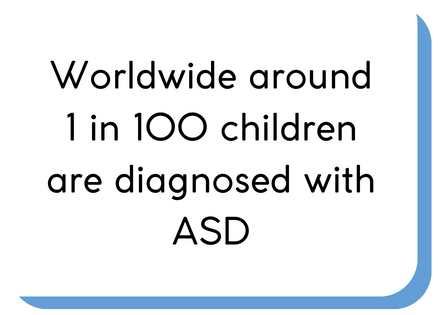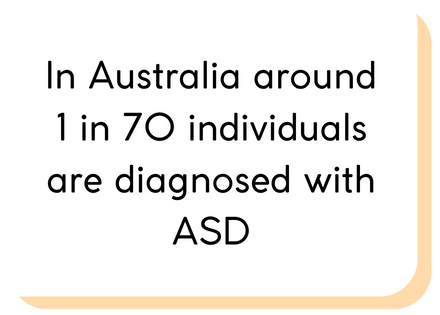Over the past three to four decades, there has been a notable and consistent rise in the prevalence of Autism Spectrum Disorder (ASD) cases among children on a global scale. This surge prompts us to delve into the fundamental question: What factors have contributed to the increased rates of ASD?

Introduction
Previously believed to be primarily triggered by environmental factors, it is now widely understood that Autism Spectrum Disorder (ASD) is heavily influenced by neurodevelopment.
Neurodevelopment refers to the intricate development of neurological pathways in the brain, which significantly impact an individual’s development. Researchers believe that ASD symptoms are present at birth, are diagnosable from 18 months and continue throughout life, in most cases. [1]
How Many People Are Diagnosed With Autism Worldwide?
According to the World Health Organisation around 1 in 100 children are diagnosed with autism ASD worldwide. [2]

How Many People Are Diagnosed With ASD In Australia?
In 2018 there were 205,200 Australians diagnosed with ASD, a 25.1% increase from the 164,000 in 2015.[3]

The prevalence of ASD in Australia is estimated to be around 1 in 70 individuals, and these rates are consistently increasing. [4]
Understanding Differences In How Children Are Diagnosed With ASD
Children often receive diagnosis in outpatient settings, where standardisation of diagnosis procedures and record-keeping practices may vary.
This means that across different countries, states, or even individual practices, there can be discrepancies in how children are diagnosed. Furthermore, the diagnostic process is susceptible to biases based on the evaluator, access to services, and cultural factors, all of which can influence the prevalence of diagnoses [5].
As we delve further, it becomes evident that modifications in the diagnostic criteria have significantly contributed to addressing these disparities.
Factors That Impact ASD Diagnosis
Many attribute these increases to changes in diagnostic criteria, new assessment instruments, inaccurate diagnoses, using different research methodologies to identify prevalence estimates, cultural differences, and increases in autism awareness. [1]
The picture can be further complicated by diagnosis changes where a child may have been diagnosed with a language disorder, for example, but then this is then replaced with an ASD diagnosis, also known as diagnostic substitution.

Equally, a child may be developing typically and then rapidly lose speech or social skills later on and begin engaging in some repetitive or restricted behaviours, also referred to as a “regression”.
Moreover, in the past, restrictions on accessing confidential medical or educational records posed challenges in obtaining complete and unbiased information about autism prevalence. [5]
However, with the advent of digital clinical records, clinicians now have better access to medical records, which may facilitate easier and more accurate reporting of ASD diagnoses.
Changes In Diagnostic Criteria
The DSM, short for the Diagnostic and Statistical Manual of Mental Disorders, is a handbook that healthcare professionals use to diagnose mental disorders.[6]
It has undergone significant changes over the past 70 years, and these changes might help explain why we’re seeing more cases of ASD being diagnosed.
The release of the DSM-III in 1980 introduced specific diagnostic criteria, reducing the reliance on clinician interpretation. In 1987, further adaptations were made, broadening the concept of ASD to include a milder end of the spectrum. It also noted that ASD included a spectrum of conditions, rather than a single condition.
In 1994 the DSM IV, went into more detailed criteria, with this version having the biggest impact on diagnosis rates.
Finally the DSM 5 was released in 2013 with further refinements including the levels of severity. These changes likely contributed to the increase in the number of diagnoses particularly for those born from 1994. [7] For example, instead of being diagnosed with Asperger’s syndrome, a person would instead be diagnosed with ASD level 1, which is on the milder end of the Autism spectrum.

New Assessment Instruments
The increased prevalence of autism diagnosis in children is partly due to advancements in assessment instruments, focusing on early screening for timely interventions.
Screeners developed for primary care settings identify symptom severity and potential cases, leading to appropriate referrals.
The assessment process involves parental interviews, forms like the Autism Diagnostic Interview-Revised (ADI-R), and intellectual assessments, providing a comprehensive understanding of challenges and aiding diagnosis.
These refined instruments improve early screening and diagnostic accuracy, allowing for timely support and improved outcomes for individuals with autism.[8]
Different Research Methodologies
The research shows that when we look at ASD using a method where we actively assess people (called prospective diagnostic assessments) rather than just looking at past records (retrospective records), we tend to find more cases.
This suggests that how we diagnose and when we do the assessments can change how many cases of ASD we think are out there. [9]
Cultural & Geographic Factors
Research shows many children worldwide are not diagnosed as early as they could be. One reason for this delay is the lack of tools that are specifically designed for different cultures and are available in various regions, creating a gap in early identification processes both within and between countries. [10]
In the USA, racial disparities in autism prevalence have been observed over time, indicating a trend of “catch-up” in the diagnosis of minorities who were initially underdiagnosed. [11]
Additionally, some studies have shown that people with ASD in rural areas often struggle to access the necessary diagnosis, treatment, and support services. This is due to various challenges, including the long distances between families and service providers and a limited number of healthcare professionals. [12]

Increasing Awareness Of Autism
Increased global awareness and advocacy for ASD have been complemented by developments in human rights, maternal and child health, and mental health policies.
The United Nations Convention on the Rights of Persons with Disabilities (UNCRPD) has played a central role in guiding these advancements, emphasising principles such as dignity, freedom of choice, non-discrimination, full participation in society, and recognising people with disabilities as part of human diversity.
Furthermore, the World Health Assembly approved the WHO’s Comprehensive Mental Health Action Plan 2013–2020 (WHO, 2013b), advocating for access to “high-quality, culturally-appropriate health and social care in a timely way” as well as valuing and promoting mental health. [11]

Legislation in Australia, including the Disability Discrimination Act (DDA) 1992 and Disability Standards for Education (DSE) 2005, has played a crucial role in increasing autism awareness by protecting the rights of individuals with ASD against discrimination in educational settings. These legal frameworks outline the obligations of educational institutions to provide reasonable adjustments. [4]
Conclusion
The increase in ASD rates is driven by various factors, including diagnostic discrepancies, biases, service access, and cultural influences. Changes in diagnostic criteria, advancements in assessment tools, and evolving research methodologies, especially across DSM editions, are key contributors.
Enhanced global awareness, propelled by initiatives such as UNCRPD and WHO’s Mental Health Action Plan, along with country-specific legislation, likely plays a role in the observed increase in ASD rates.
Sources:
- The increasing prevalence of autism spectrum disorders (2011)
- Autism – WHO Fact Sheet
- ABS – Disability, Ageing and Carers, Australia: Summary of Findings
- Autism in Australia: Understanding, challenges, and support
- Epidemiology of autism: Current controversies and research directions (2006)
- American Psychiatric Association – Frequently Asked Questions
- The evolution of ‘autism’ as a diagnosis, explained
- Autism spectrum disorder: psychological and functional assessment, and behavioral treatment approaches
- Systematic review of prevalence studies of autism spectrum disorders
- Early Identification of Autism Spectrum Disorder: Current Challenges and Future Global Directions
- Global prevalence of autism: A systematic review update (2022)
- Rural Trends in Diagnosis and Services for Autism Spectrum Disorder
